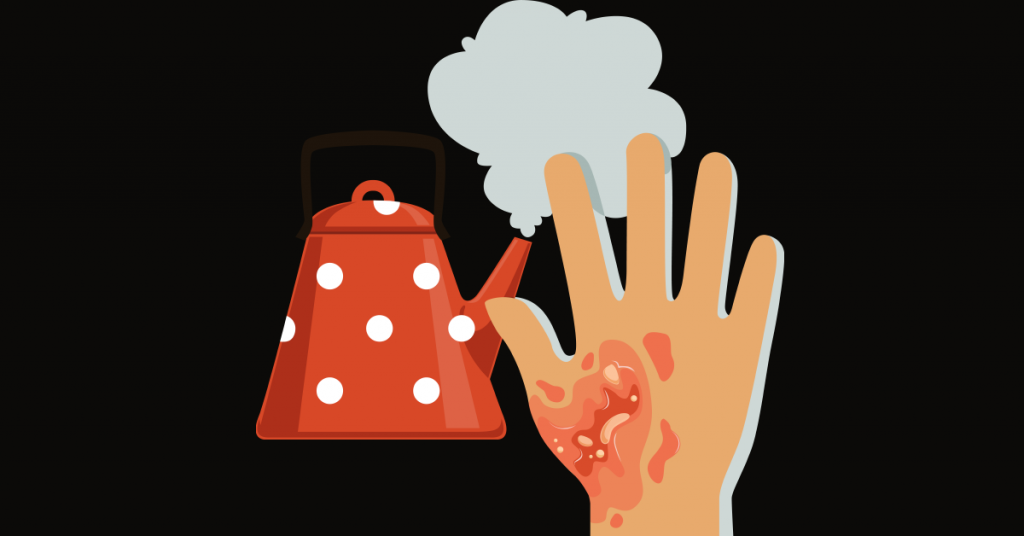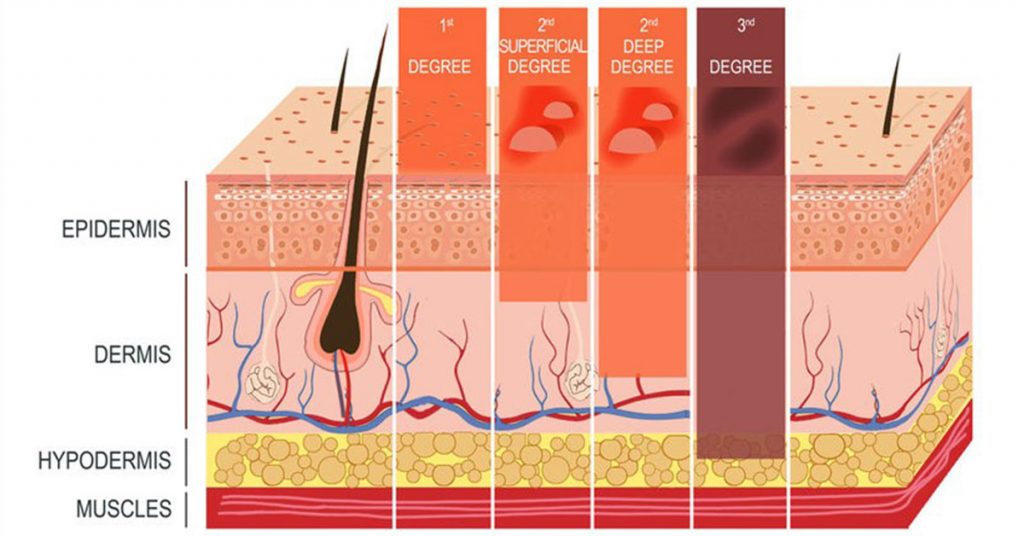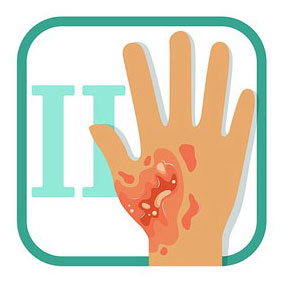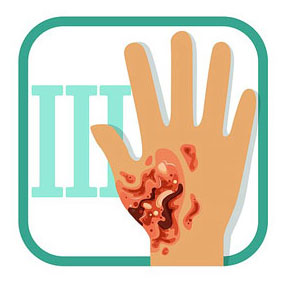
Burns are skin damage that results from heat, sunburn or other radiation, chemical or electrical contact. It is one of the most common household injuries, especially among children. The term “burn” means more than the burning sensation associated with this injury. A burn may result in a minor medical condition or life-threatening emergency.
Degrees of Burns
Burns are categorized by degree in 3 categories: first-degree or “superficial” burns; second-degree or “partial thickness” burns; and third-degree or “full thickness” burns. How these types of burns are treated initially will determine whether there is a successful outcome. (Understanding Burn Care, 2020)

1st Degree Burn

This minor burn affects only the outer layer of the skin. It may cause redness and pain. First-degree burns usually heal in about a week without scarring.
See a doctor if the burn affects a large area of skin more than three inches, and if it is on your face or a major joint.
First-degree burns are usually treated with minor first aid. Healing time may be quicker the sooner you treat the burn. Treatment can start with soaking the wound in cool water for five minutes or longer. You can then take acetaminophen or ibuprofen for pain relief. If the burn is uncomfortable, applying lidocaine (an anaesthetic) with aloe vera gel or cream can soothe the skin. Finally, using an antibiotic ointment and loose gauze can protect the affected area.
Do not use ice, as this may make the damage worse. Also, avoid home remedies like butter and eggs as these are not proven to be effective. (Healthline, 2019)
2nd Degree Burn

Second-degree burns affect both the epidermis and the second layer of skin or the dermis. It may cause swelling and red, white, or splotchy skin. Blisters may develop, and pain can be intense.
Due to the delicate nature of these wounds, keeping the area clean and bandaging it properly will prevent infection which helps the burn heal quicker. Treatments for a mild second-degree burn generally include running the skin under cool water for 15 minutes or longer. You can take over-the-counter pain medication (acetaminophen or ibuprofen). Apply antibiotic cream to blisters. If you are concerned about the severity of the burn, seek emergency medical treatment, especially if affects a widespread area.
3rd Degree Burn

A third-degree burn is the worst kind of burn. This burn reaches the fat layer beneath the skin. Third-degree burns can destroy nerves, causing numbness or intense pain. Depending on the cause of the burn, symptoms of third-degree burns can exhibit waxy and white colored skin, char, raised, and leathery texture or blisters that do not develop.(WebMD, 2019)
These wounds heal with severe scarring and skin deformity. Surgical skin grafts are often required to treat third-degree burns. There is no set timeline for complete healing, and it is a painful process. Never try self-treatment to a third-degree burn. Go immediately to the ER or call 911.
Third-degree Burn Complications
Compared with first and second-degree burns, third-degree burns carry the most risk for complications. A burn is an open wound and susceptible to bacterial infection, which may lead to a bloodstream infection called sepsis. Severe burns can also result in fluid and blood loss. Third degree burns affect our body’s ability to self-regulate and can cause dangerously low body temperature or hypothermia.
Burns caused by fires can come with other serious complications such as breathing problems from the intake of hot air or smoke. Scar tissue can cause bone and joint problems. This is a long-term healing process that requires the constant care of a physician specializing in burn care.
Preventing All Types of Burns
The best way to fight burns is to prevent them from happening. Certain jobs put you at a greater risk for burns, however the real fact is that most burns happen at home. Infants and young children are the most vulnerable to burns. Preventive measures you can take at home will minimize the opportunity.
Keep children out of the kitchen while cooking and never leave items cooking on the stove unattended. Turn pot handles toward the back of the stove and don’t carry or hold a child while cooking. Check the temperature of food before serving it to a child. Don’t heat a baby’s bottle in the microwave.
Keep chemicals, lighters, and matches out of the reach of children. Use safety latches on cabinets containing flammable materials. Don’t use lighters that look like toys, it’s too tempting to a small child. Keep hot liquids such as glue guns or melted wax out of the reach of children and pets. Most importantly, place a fire extinguisher in or near the kitchen.
General home precautions are easy to practice and maintain. Test smoke detectors once a month and replace smoke detectors often or service them frequently. Make sure battery-operated smoke detectors have working batteries. Keep the water heater temperature under 120 degrees and always test bathwater temperature before stepping into the tub or shower. Never forget to unplug irons and similar devices when not in use and store them out of reach of small children. When using chemicals, always wear protective eyewear and clothing.
Finally, when outside, wear sunscreen every day and avoid peak sunlight. Follow the directions on the sunscreen bottle for frequency of application. Most sunscreens don’t last a whole day and need to be reapplied. (Mayo Clinic & Healthline, 2020)
When You Have a Burn
It’s important to seek adequate medical treatment for burns. Part of the healing process for severe burns includes help for your emotional needs. Extensive burns of the body can take many years of medical treatment, surgery and physical therapy. These are life-changing to your health and emotional well-being. There are support groups available for people who have experienced severe burns, as well as certified counselors. Organizations such as Shriners Hospital for Children and The Burn Institute promote physical and emotional care for burn survivors.
Stay Safe
Taking precautionary measures is what keeps our loved ones and family safe around heat sources, open flames and dangerous chemicals. Keep a first-aid kit on hand. Go over the dangers of burns with small children and be sure toddlers are kept at a distance. It only takes a second for a burn to happen. Education and information are the best way to know how to deal with a burn injury.
Work Cited
“Determining Burn Severity.” Burn Severity. N.p., n.d. Web. 18 Aug. 2020. http://understandingburncare.org/burn-severity.html
Solan, April Khan, and Matthew. “Burns: Types, Symptoms, and Treatments.” Healthline. Healthline Media, 22 June 2019. Web. 18 Aug. 2020. https://www.healthline.com/health/burns
DerSarkissian, Carol. “Treating Pain Caused By Burns: 1st, 2nd, and 3rd Degree.” WebMD. WebMD, 25 Apr. 2019. Web. 18 Aug. 2020. https://www.webmd.com/pain-management/guide/pain-caused-by-burns
“Burns.” Mayo Clinic. Mayo Foundation for Medical Education and Research, 28 July 2020. Web. 18 Aug. 2020. https://www.mayoclinic.org/diseases-conditions/burns/symptoms-causes/syc-20370539
